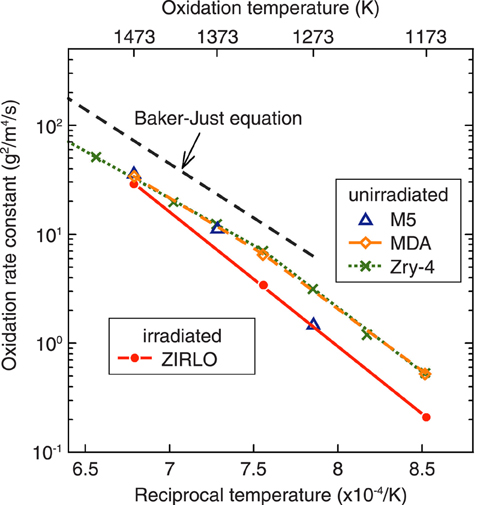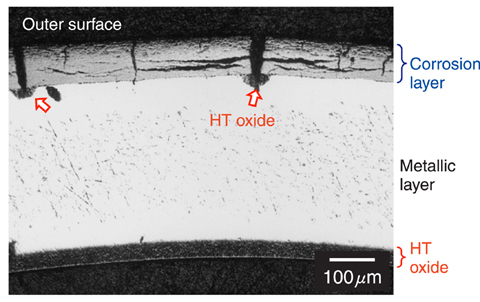
Fig.5-4 Temperature dependence of the oxidation rate constants, calculated from mass increase

Fig.5-5 Radial cross section of the irradiated ZIRLO cladding after high-temperature oxidation test
Extension of the utilization period of reactor fuel, i.e. burnup extension, is being promoted worldwide for efficient use of natural resources etc. We performed experiments under simulated accident conditions to investigate the effects of long-term irradiation on fuel behavior during accidents and confirm fuel safety.
A loss-of-coolant accident (LOCA) is one of the postulated accidents considered in the safety design of a nuclear power plant. In LOCA conditions, fuel cladding is oxidized due to zirconium-steam reaction at high temperatures, and loses ductility when severely oxidized. Accordingly, it is very important to evaluate the oxidation kinetics precisely for the safety analysis. As burnup is extended, the corrosion layer grows and hydrogen absorption becomes more significant in fuel cladding, which may affect the high temperature oxidation under LOCA conditions. On the other hand, advanced alloys are being developed to improve corrosion resistance and help achieve higher burnup. It is necessary to investigate fuel behavior with the newly developed cladding under accident conditions. Hence, we performed isothermal oxidation tests with cladding that had been irradiated for a long time in European power plants in order to investigate the effect of high burnup and alloy composition on the high temperature oxidation.
The oxidation rates calculated from mass increase are summarized in Fig.5-4. The rate constants of high burnup ZIRLO cladding are lower than those of the unirradiated cladding at relatively low temperatures, while thedifference is small at 1473K. Fig.5-5 shows the microstructure in a radial cross section of an irradiated ZIRLO specimen after the high-temperature oxidation test. A thick corrosion layer that formed during the reactor operation is seen at the outer surface. The high temperature oxidation (HT oxide) appears to initiate at the positions where cracks are seen in the corrosion layer. It is generally accepted that the mechanism which governs the high-temperature oxidation of Zirconium alloy cladding is the diffusion of oxygen anions through the oxide layer. It is considered that the pre-formed corrosion layer suppressed the high-temperature oxidation by preventing the diffusion of oxygen to the surface of the metallic layer. On the other hand, increase in hydrogen absorption and changes in alloy composition had very little influence on the oxidation rate. The Baker-Just oxidation kinetics equation was found to still be applicable to the safety analysis of the high burnup fuel cladding in a LOCA.
The present study was conducted in FY2007 as part of the "Advanced Light Water Fuel Performance and Safety Research Program" commissioned by the Nuclear and Industrial Safety Agency (NISA) of the Ministry of Economy, Trade, and Industry (METI).